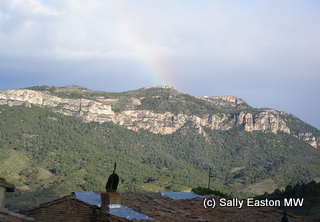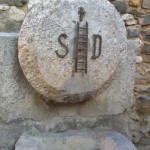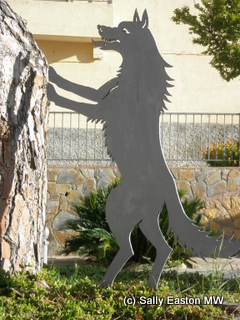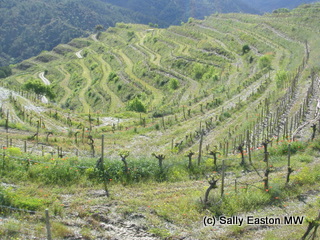Priorat(o)

Rainbow on Montsant
The microscopically concertina-ed hilly landscape of remote, picturesque Priorat (Catalan)/ Priorato (Castilian) is not for the faint-hearted or travel-sickly, but it is well worth the pain and consequences of both to appreciate the scenery and the wines.
The small region is located in the province of Tarragona. It’s about 90 miles and a couple of hours’ drive south west of Barcelona, tracking the coastline before finally heading inland.
It’s roughly 10 kilometres across at its widest point, by about 12 km north to south, and is protected by the Sierra de Montsant in the northwest. The mountain gives its name to another DO, Montsant, which almost completely encircles Priorat (separate article will follow shortly). The vineyards range from 100m to 700m above sea level, necessarily on terraces due to the tightly-folded mountainous terrain. The river Siurana runs through Priorat into the river Ebro on its way from the Rioja region to the Mediterranean sea.

Scala Dei
Priorat takes is name from a priory – the Priorato de Scala Dei (Priory of the Stairway of God) – after an Order of Carthusian monks arrived in 12th century. The winery in this tiny settlement, Scala Dei, is now owned by Cava house Codorníu).
So vines have been grown in Priorat for centuries, but the wines achieved acclaim as recently as the 1990s, after a ground-breaking group of growers moved in to the tiny hilltop village of Gratallops to make wine. In 1979, it was René Barbier of Clos Mogador, whose family business was relatively nearby in Penedès, who first recognised the region’s potential to produce top quality wine. The friends started by producing a wine each labelled ‘Clos’ to distinguish themselves from the traditional rustic, baked fruit style of wine from the region.
They were, with the current names of their properties:
| René Barbier | Clos Mogador | (wine and winery) |
| José Luis Pérez | Clos Martinet | (wine); Mas Martinet (winery) |
| Alvaro Palacios | Clos Dofi | (wine, renamed Finca Dofi in 1994) |
| Carles Pastrana | Clos de l’Obac | (wine); Costers del Siurana (winery) |
| Daphne Glorian | Clos Erasmus | (wine and winery) |
1989 was their first vintage, at which time the vineyard area had dropped to a low point of about 600 ha. After phylloxera, and after the Civil War, the region was quite isolated, and during the 1940s and ’50s people were migrating to the industrialising cities of Tarragona and Barcelona.

Howling of the wolves
It was at the hilltop village, and heartbeat of ‘new’ Priorat, Gratallops, that these late 20th century pioneers congretated. This is a village that has barely changed for years, but has seen a regrowth in population to 300 thanks to Priorat’s revival. Gratallops translates as ‘howling of the wolves’, reflecting the fauna of its original remote location; local art installations pay homage to this heritage.
Their early success in crafting top quality wines, often from very old vines and small yields, has drawn in numerous other people to the region, both Spanish and foreign investors. Further acknowledgement was achieved when the DOQ (Catalan)/ DOCa (Spanish) was awarded in 2000, effective from the 2000 vintage. Up till then only Rioja DOCa had the highest quality level of the Spanish wine system.
Mechanisation is virtually impossible in this terrain, and it is the combination of soils and grape varieties that create the serendipitous conditions for strong, muscular red wines that yet retain a certain amount of attractive freshness that is not often found in the warm, sometimes hot, Mediterranean climate of much of Spain.
There are 1,600 hectares (ha) of vines, 40% planted to garnacha (grenache in French), another 30% planted to cariñena (carignan in France), plus 20% to international interlopers cabernet sauvignon, merlot and syrah, thought to ‘soften’ the dense, dark, spiciness of the other two. There’s also 100ha of garnacha blanca and macabeo (a.k.a. viura, as in Rioja). Alvaro Palacios, of the eponymous winery, may be drawing away from the international varieties, but Carles Pastrana with his Clos de l’Obac is happy that the three comprise more than 50% of the blend.

Llicorella with root network
The llicorella soil, a local name for the rocky slate and schist which is rich in sparkly quartzite, provides one of the defining characters for Priorat wines. Palacios, who is now more famous for his top L’Ermita wine, said the llicorella is a “metamorphic rock, formed under the earth’s crust where two horizons of limestone had compacted a layer of clay. It has three times more metals and minerals than sedimentary rock [that has not undergone metamorphosis]. The slate is red brown at Finca Dofi, with lots of iron oxide, and very warm. At L’Ermita, there is cooler green slate, which has higher aluminium and zinc.” The exposition and altitude of these two vineyards is also different, but the llicorella is argued to have a primary role in each wine’s flavour profile.
Thin clay layers are important. The region has less than 400mm annual rainfall, which would usually demand irrigation for vineyards, and some irrigation does exist here. But not everywhere. Palacios added: “we have 35% clay in the licorella. The layers of slate have clay powder in between which retain moisture.” Barbier added that vine roots penetrate the llicorella, and a fine mat of roots develops in the layers where the moist clay powder resides, able to draw on the moisture. With the tiny yields garnered by top producers, it would seem that this is sufficient to keep the vine watered through the dry Mediterranean summer.

Clos Mogador
For producers such as Barbier and Palacios, working the land as naturally as possible is important. The amphitheatre of the narrowly-terraced Clos Mogador vineyard is covered with grasses and flowers in Spring, which are mown by hand-held strimmer after they’ve flowered, to give the vine more air. The foliage is then ploughed into the soil over the summer. Barbier is a man convinced by the benefits of biodiversity, and retains the traditional cherries, almonds, peaches, and olives interspersed with his vineyards.
Over the past three or four years Priorat producers have been developing a ‘village’ concept for some of their wines. Called ‘Vi de Vila’ (wine of the village), all the fruit used must come from the property of the producer and be within the newly-defined viticultural boundaries of the village (which differ from the administrative boundaries). The idea is that each village may have (or become to have) its own identity. Thus Palacios’ new Vi de Vila is called Gratallops, as the vines are within the Gratallops borders. The first vintage, 2007, will be released during 2009. Other villages include Porrera, Poboleda and Bellmunt.
Vintage conditions are also important in this warm area. 2003, 2004 and 2005 were very hot. 2006, 2007 and 2008 were a little cooler. This shows in the wines, with greater elegance and freshness (acidity) in the more recent vintages. The wines retain their famed muscularity and broad shoulders, but a little coolness seems to tone their brute strength and slim the waist to more attractive proportions.
Such is the region’s stellar reputation that producers are still coming to Priorat, with the number reaching nearly 100, from about 70 in the last quarter of 2008. But they pay the price for land. What cost less than €1,000/ha 30 years ago, was costing something like €60 to €80,000 /ha a couple of years ago.
This article was inspired by a visit to the region sponsored by Wines from Spain.



